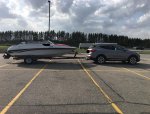Hi All,
Newcomer to iBoats and loving the online environment! Question about towing a boat. When I had my single axle pop-up trailer that I towed with my minivan, the trailer always made the back of my van sag low. Could never figure out why since I constantly saw other vans like mine pulling heavier camper trailers with no sag at the rear. I tried installing airbags in the van suspension springs which helped a bit but not much.
Fast forward to a boat I just bought and plan to tow with a new SUV of the same tow capacity limit as my van, but boat and trailer together will weigh in much closer to that tow capacity limit.
Could it be as simple as buying the right height hitch so that the ball is raised and level with the receiver of the boat trailer - when the boat trailer is sitting level?
http://ststatic.blob.core.windows.n...class-iii-fusion-trailer-hitch-ball-mount.jpg
Newcomer to iBoats and loving the online environment! Question about towing a boat. When I had my single axle pop-up trailer that I towed with my minivan, the trailer always made the back of my van sag low. Could never figure out why since I constantly saw other vans like mine pulling heavier camper trailers with no sag at the rear. I tried installing airbags in the van suspension springs which helped a bit but not much.
Fast forward to a boat I just bought and plan to tow with a new SUV of the same tow capacity limit as my van, but boat and trailer together will weigh in much closer to that tow capacity limit.
Could it be as simple as buying the right height hitch so that the ball is raised and level with the receiver of the boat trailer - when the boat trailer is sitting level?
http://ststatic.blob.core.windows.n...class-iii-fusion-trailer-hitch-ball-mount.jpg
Last edited:




















